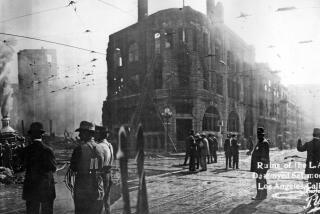Blackmail Can Lead to Terrorist’s Downfall : Unabomber: News organizations have been coping with such threats for years. Cooperation with criminals occasionally has helped crack seemingly unsolvable cases.
- Share via
For 16 years he planted bombs across New York City, terrorizing the populace with powerful explosions in department stores, theaters and subways. He concealed his crude devices in woolen socks and identified himself with a distinctive signature--”FP” for Fair Play.
Driven by a grudge stemming from an industrial accident, the bomber detailed his gripes in a series of angry messages published by a newspaper. In the end, he was trapped by his own words--captured after someone recognized a telling phrase that had appeared in print.
The year was 1957, and the terrorist was George P. Metesky, the legendary Mad Bomber of New York. In granting Metesky’s wish to have his writings published, the now-defunct Journal-American newspaper helped crack a case that had stumped the best minds in law enforcement for years.
Last week, in a case with striking parallels, publishers of the New York Times and Washington Post joined together to print the writings of another mysterious bomber--the Unabomber, who has killed three people and injured 23 over a span of 17 years.
Critics fear that the papers’ publication of the Unabomber’s manifesto, an eight-page supplement in Tuesday’s Post, sets a worrisome precedent, but in fact, news organizations have been coping with such threats for years--and occasionally giving in.
Off and on throughout this century--from Los Angeles to Indianapolis, and from cult leader David Koresh to the Mad Bomber of New York--the media have sought to prevent bloodshed by yielding to the demands of kooks, killers and terrorists.
“We have a long tradition of cooperating with the police under some circumstances and clearly any sensible person knows we ought to do that--under some circumstances,” said Louis Hodges, who teaches journalism ethics at Washington and Lee University in Virginia.
Although many journalists have qualms about newspapers buckling to terrorists, he said, most readers view it as a no-brainer: Saving a life should come first.
In 1993, a Dallas radio station agreed to broadcast a message from Koresh during his standoff with federal authorities in Waco, Tex. After the broadcast--made at the request of the United States government--Koresh kept his word and released more than 20 children who had been living in the Branch Davidian compound.
Koresh then offered to surrender if the station played an hourlong sermon over the air. Radio executives complied, but Koresh broke his vow, saying that God had told him not to give himself up.
“We felt the goal of trying to save lives outweighed the argument that we, as journalists, were being used by the federal government,” said Charlie Seraphin, manager of KRLD at the time. “In the end, of course, Koresh heard another voice and reneged on his promise.”
Such treachery is often the norm. Typically, experts say, terrorists and others with axes to grind cannot--and should not--be trusted. Typically, news executives confronted with extortionist demands dismiss them out of hand or consult with police and refuse to cooperate.
But sometimes, circumstances make allegiance to such an inflexible policy seem cruel or unwise.
Take the case of Patty Hearst, the newspaper heiress who was kidnaped by the revolutionary Symbionese Liberation Army from her Berkeley apartment in 1974. When the SLA demanded that a string of messages be published in the family’s newspaper, the San Francisco Examiner, her shaken father--then-Editor Randolph A. Hearst--quickly complied.
“All communications from this court MUST be published in full, in all newspapers, and all other forms of the media,” the demand letter from the SLA said. “Failure to do so will endanger the safety of the prisoner.”
Thomas Eastham, Examiner executive editor at the time, said the decision to publish was “a very personal one, given the family considerations.”
“There was considerable controversy on the staff as to whether we were doing the right thing,” said Eastham, now vice president of Hearst Foundations. “It was an exercise in futility. None of this seemed to be having an impact on getting Patty back, and ultimately, of course, it did not.”
Another case of agonizing decision-making involved the 1976 demands of Croatian nationalists, who had hijacked a jet in New York and killed a police officer with a bomb planted at Grand Central Station. The terrorists threatened to set off another bomb and kill their hostages if major newspapers did not print an eight-page communique on the front page.
The New York Times, Washington Post, Chicago Tribune and Los Angeles Times all quickly published the hijackers’ tract, which decried Serbian domination of Yugoslavia and demanded creation of an independent Croatia. The terrorists surrendered soon after in Paris, releasing their 62 hostages unharmed.
Benjamin C. Bradlee, then executive editor of the Post, writes in a recent book that he regrets bowing to the threat but did not want to risk the loss of more lives.
“The truth is that none of us had any stomach for reading a headline in the next day’s paper that went something like this: ‘Hijackers Kill 62 Americans After U.S. Editors Refuse to Publish Documents,’ ” Bradlee wrote in his book, “The Good Life.”
The case of the Mad Bomber of New York is perhaps the nation’s most fascinating episode of media extortion. Because of its happy conclusion, FBI agents now hunting the elusive Unabomber also hope that it will prove prophetic.
A son of Lithuanian immigrants, Metesky set his first bomb in 1940. Over the next 16 years, he planted 31 more, injuring 15 people, several seriously.
Metesky’s motivation was rooted in an accident he suffered on the job at New York’s electric company. Employed as a generator wiper, he was knocked down by a burst of hot gases when a boiler exploded. Doctors found no injuries, but he filed a claim seeking disability retirement, insisting that the accident had given him tuberculosis. The claim was denied, and Metesky never returned to work.
Instead, he sat at home--his grievances festering--and plotted his revenge. After nine years of patient ruminating, he set his first bomb, a pipe filled with gunpowder that did not explode. Over time, the bombs became more powerful, though he later told police he used to pray that no one would be hurt by his devices, “especially on Sunday.”
In deference to World War II, Metesky took a long break from bombing. But then he resumed--and began writing letters to the Journal-American. In an unusual twist, the newspaper published an appeal to the Mad Bomber, asking him to provide details of his troubles--and even offering legal and medical help if he gave himself up.
Unable to resist, Metesky responded with more letters, hinting at various “dastardly deeds” and “ghoulish acts” that had driven him to bomb. As it turned out, those messages sealed his downfall.
Police had long suspected that the bomber was a disgruntled former employee of the electric company. One day, prowling through old personnel files, a secretary at the utility came across one marked “Metesky, George.” In it were angry letters accusing the company of “dastardly deeds.”
When they knocked on Metesky’s door in Westbury, Conn., police found an affable man in gold-rimmed spectacles, a bachelor who lived with his two elderly sisters. Neighbors described him as quiet but occasionally crochety. They mentioned that he spent a good deal of time in his garage, where police found a tidy workbench and tools meticulously arranged in neat rows.
As the Metesky story shows, publication of a terrorist’s writings can provide the key break in a seemingly uncrackable case. In its biggest manhunt ever, the FBI has spent 17 years and tens of millions of dollars searching for the Unabomber. If his manifesto is published, they reason, perhaps someone, will recognize something that leads them to the bomber’s door.
They may well be right. Putting aside the vexing issue of journalism ethics, a review of numerous episodes of media extortion shows that giving in to a terrorist’s demand can have a positive bearing on the outcome of a crisis. To wit:
* In 1977, an Indianapolis gunman who believed he had been defrauded by a mortgage firm took the company’s director hostage, holding him for 63 hours with a shotgun wired to his head. Reporters were staking out the scene when suddenly the gunman appeared with his hostage, demanding to go live.
“Turn on your cameras!” he shouted. “I want to talk on national television. I’m a . . . national hero, and don’t you forget it.” For nearly 30 minutes, he ranted, raved, wept and shouted obscenities on live TV. Then he released his hostage and was arrested.
* In 1983, a mentally ill man shot a junior high school principal and a student, then held 18 other students hostage in a Brentwood, N.Y., classroom to seek revenge for his firing. After a radio station complied with his demand to play specific songs--including the Beatles’ “Penny Lane”--he killed himself.
* In 1993, when inmates in Lucasville, Ohio, seized the state’s maximum-security prison and kidnaped eight guards, they traded one of their hostages for radio and TV broadcasts to air their grievances. They surrendered after an 11-day siege that left one guard and seven inmates dead.
At other times, however, television executives have been reluctant to allow their broadcasts to be taken over by gunmen with a message, even if it meant risking the lives of employees:
* In 1984, a gunman in Greensboro, N.C., who had killed one television station employee and kidnaped a second demanded that the station apologize on the air for spying on him through his TV set. Station managers taped an apology but broadcast it only to the man’s home, where he had taken the hostage. Unaware that he had been tricked, the gunman surrendered.
* In 1987, a man walked onto the set at KNBC-TV, Channel 4, in Los Angeles and pointed a gun at consumer reporter David Horowitz in mid-broadcast. News director Tom Capra immediately took the show off the air, risking Horowitz’s life because the gunman could see on TV monitors that he was no longer being broadcast.
After Horowitz read the man’s rambling eight-minute statement about UFOs, clones and the CIA, the gunman surrendered. The weapon turned out to be a toy.
But afterward, an incredulous Horowitz questioned the station’s wisdom in protecting its integrity at the risk of his life. Capra replied: “You can always get out of the business.”
The Unabomber’s demand--while part of a long tradition--represents the most complex episode of media extortion yet, experts say. Ben Bagdikian, a former dean of the UC Berkeley graduate school of journalism, said that in most instances “there is a very explicit deal demanded: You do this in X number of hours or we kill the hostages.”
But the Unabomber has upped the ante, demanding publication of his 35,000-word manuscript and three annual follow-up articles. Further complicating the equation, there is no telling who or where his next victims would be--and there is no offer of surrender.
“It’s the most spongy thing newspapers have had to deal with,” Bagdikian said.
Times researchers Janet Lundblad and Norma Kaufman contributed to this story.
More to Read
Sign up for Essential California
The most important California stories and recommendations in your inbox every morning.
You may occasionally receive promotional content from the Los Angeles Times.










